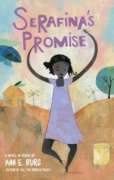by Carmen M. Martinez-Roldan and Katherine Lorena del Carmen Keim-Riveros
In our last blog of the month we focus on how the authors’ incorporation of non-English words in Afro-Latino and Afro-Caribbean literature can contribute to a better understanding and appreciation of the richness and complexities of Latino culture and the bilingualism of their communities. The books discussed through this month were all English-based texts, in which the authors purposefully incorporated the linguistic repertoire of the communities they were representing by incorporating a few carefully selected words or phrases strategically, skillfully, and with cultural sensitivity, as Barrera and Quiroa (2003) recommend. These selected non-English words served to create powerful bilingual images that support readers’ understanding of characters, settings, and themes. To exemplify this use, we comment on the use of language in Serafina’s Promise by Ann. E Burg. Graduate student, Katherine Lorena del Carmen Keim-Riveros, shares her perspectives on the story.
 Serafina’s Promise is a first-person narrative told from Serafina’s point of view, an 11-year old girl living in Haiti, who has a big dream: to become a doctor. Serafina lives on the hills of Port-au-Prince and has never had the opportunity to go to school, because her family lives in marginal poverty. However, although her family does not have much food to eat and is constantly struggling with money, Serafina has hope. Gogo (Serafina’s grandma) reminds her: “Lespwa fe vin/Hope makes us live.” Certainly, ‘hope’ is a central theme in the novel and the lives of a community surviving many natural disasters and the author’s use of Kreyòl (Creole in English) to signal this theme is relevant and important.
Serafina’s Promise is a first-person narrative told from Serafina’s point of view, an 11-year old girl living in Haiti, who has a big dream: to become a doctor. Serafina lives on the hills of Port-au-Prince and has never had the opportunity to go to school, because her family lives in marginal poverty. However, although her family does not have much food to eat and is constantly struggling with money, Serafina has hope. Gogo (Serafina’s grandma) reminds her: “Lespwa fe vin/Hope makes us live.” Certainly, ‘hope’ is a central theme in the novel and the lives of a community surviving many natural disasters and the author’s use of Kreyòl (Creole in English) to signal this theme is relevant and important.
The novel is sprinkled with Haitian Kreyòl phrases and Haitian proverbs and sayings and the author includes at the end a ‘Haitian Creole Alphabet and Pronunciation Guide’ and a ‘Glossary of Foreign Phrases.’ However, the way Burg uses Kreyòl in the dialogues is contextualized, enabling readers to understand the meaning of words and phrases without the need of the glossary, as in the following example:
Serafina: Bondye Bon! we all sing.
We raise our arms
and clap our hands.
Bondye Bon! God is good!
Serafina: Mwen dwe travay, I call,
Moving only my eyes.
I have work to do!
Serafina: But Banza isn’t dangerous.
He’s my friend.
Right, Banza? I say.
Ou se zanmi nwen.
You’re my friend.
In addition to incorporating Kreyòl in the story, the author explicitly refers to the French/Kreyòl-language instruction in Haitian schools in a way that contributes to the cultural authenticity of the novel, because the use of Kreyòl in education represents a relevant issue in Haiti. In the novel, we can see Serafina questioning why she has to learn in French instead of her language.
Serafina: I like learning to write.
And I like listening to stories about Haiti.
But I don’t like learning French!
Why can’t we learn in Creole?
Then everyone could understand each other.
How does learning French help people?
Kreyòl is the native language of most Haitians, rather than French, the language traditionally used in schools and spoken by only a tiny elite. However, even though Kreyòl has been recognized as a co-official language with French, Kreyòl-speaking children continue to be taught in French at school and French has high prestige. According to Degraff (as cited in Dizike, 2015), over 95% of the population is fluent in Kreyòl only, and Spears (2010) adds that perhaps three-quarters of a million to a million Haitian immigrants in the U.S. speak the language. The language situation mirrors and reinforces the social, economic, and cultural differences that continue to separate the educated elite from the rest of the society, which lives in a situation of marginalization and deep poverty.
The use of Kreyòl is a complex matter in Haiti and in the United States, because many myths are abound regarding Afro-Caribbeans (West Indian Americans or Caribbean Americans in USA) and the language(s) they speak. For some, the association of the French language with Europe promotes a positive image while the association of Haitian Kreyòl with Africa promotes a negative one. Thus, Kreyòl is seen by some as an inferior language, and French is seen as a prestigious language that deserves to be taught. Multicultural and international literature has the potential to change these attitudes toward Kreyòl and other minoritized languages and promote social justice and equity. By incorporating this literature in the classroom and supporting critical discussions, linguistic diverse students may reclaim aspects of their identity, as Serafina did:
Inside our crowded classroom,
we sit with shoulders touching
while Monsieur Leblanc
TAP TAP TAP TAPs.
Le soleil brille.
The sun shines in French,
the language of our conquerors.
But outside, before school,
Solèy la klere.
When jump rope
or fly kites,
when we play hide-and-seek,
soccer, or rocks and bones,
Solèy la klere.
When I gather water
or pull weeds,
when I wash clothes,
or sing to my brother,
Solèy la klere.
The sun shines in Creole,
the language of our ancestors
Teachers can also use this literature in their classrooms to support meaningful discussions about language and power that may contribute to combat distorted images of Caribbean people, Haitian-Americans, Puerto Ricans, Dominican-Americans, Jamaicans and other immigrants from the Caribbean or other countries and promote a positive representation of them and their language(s).
Serafina’s Promise provides strong cultural markers of the Haitian culture. It challenges readers to think outside the box and formulate new meanings, because it mirrors the everyday occurrences in Haitian’s lives (McKoy Lowery, 2015). Multiple critical readings could bring different interpretations of Burg’s novel, a reflection on gender roles, on inequities, and on the history of US-Haiti relationships, among others. In this post, we focus on language to gain an understanding of how intertwined language and identity may contribute to the development of cultural understanding among students of various backgrounds. As McKoy Lowery states, it is crucial that as educators we emphasize the fact that literature reflects and influences society, because it has the power to shape our lives. Multicultural and international literature is needed to raise cultural awareness, and Serafina’s Promise is a great resource educators can use to explore Haitian culture and language with their students.
References
Barrera, R. B., & Quiroa, R. E. (2003). The use of Spanish in Latino children’s literature in English: What makes for cultural authenticity? In D.L. Fox & K.G. Short (Eds.), Stories matter: The complexity of cultural authenticity in children’s literature (pp. 247–265). Urbana, IL: National Council of Teachers of English.
Dizike, P (Interviewer) & Degraff, M. (Interviewee). (2015). 3 Questions: Michel DeGraff on Haiti’s new policy for teaching in Kreyòl. Retrieved from http://news.mit.edu/2015/3-questions-michel-degraff-haiti-teaching-kreyol-0720
McKoy Lowery, R. (2015). Glimpses of the Caribbean: Jamaicans in the Américas Award Winning Books. In Henderson, L. (Ed.) (2016). The Américas Award: Honoring Latin@ Children’s and young adult literature of the Americas. Lanham, Maryland: Lexington Books.
Spears, K. A. (2010). Introduction: The Haitian Creole language. In A. K. Spears, Carole. M. Berotte, & A. Valdman. (Ed). (2010). The Haitian Creole Language: History, Structure, Use, and Education. UK: Lexington Books.
Please visit wowlit.org to browse or search our growing database of books, to read one of our two on-line journals, or to learn more about our mission.

